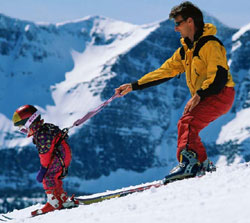 Alpine skiing is often considered one of the most dangerous winter sports around, especially with the horrific crash videos replayed during the evening sports casts.
Alpine skiing is often considered one of the most dangerous winter sports around, especially with the horrific crash videos replayed during the evening sports casts.
But, according to a study in the journal Sports Health: A Multidisciplinary Approach, skiing is no more dangerous than riding in a car or on a bicycle.
Reviewing literature on the 12 most common topics relating to skiing, lead author, Robert J. Johnson, MD, Emeritus Professor of Orthopaedics at the University of Vermont, found that "all or at least part of each of the myths could not be
substantiated."
Catastrophic Injury Risk
Myth: Skiing is among the most dangerous of activities.
Truth: The approximate annual fatality rate per million hours of exposure associated with cars (~0.30) and bicycles (0.07) is essentially the same as that for skiing (0.12).
Injury Types
Myth: Broken legs have been traded for blown-out knees
Truth: The increase in anterior cruciate ligament injuries came later than did the decrease in lower leg injuries; the two groups involve completely different mechanisms of injury.
***
Myth: Formal ski instructions will make you safer.
Truth: In most studies done in North America and Europe, skiing lessons did not decrease the risk of injury and have not been shown to be an effective method for injury prevention.
***
Bindings
Myth: All you need to know is your DIN (release indicator value) number and you can adjust your bindings.
Truth: Inspection and calibration of ski bindings is a complex process that requires specialized tools, equipment and properly trained technicians.
***
Myth: Toe and heel pieces must be set to the same Release Indicator Value or the bindings won't function properly.
Truth: Today's standards allow for personalized release/retention settings that may result in different indicator values at the toe and the heel.
***
Myth: The shorter the ski, the less torque is applied to the leg in a fall, so short skis and snowboards don't need release bindings.
Truth: Several studies have found between a three- to twenty-fold increase in the incidence of ankle and tibia fractures for snowboarders compared to traditional alpine skis. Release bindings should be a requirement for skis of any length.
***
Myth: Tighter standards that mandate lower release settings will reduce the risk of injury to the ACL.
Truth: The primary mechanisms for ACL injury is not related to binding function, so any reduction in the binding release values would not reduce the risk of ACL injury but could increase the frequency of inadvertent releases.
Children's Equipment
Myth: Young bones bend rather than break, so there is no point in spending a lot of money on children's equipment.
Truth: Children are at highest risk for potential equipment related injuries, and therefore require properly functioning equipment if that risk is to be minimized.
***
Myth: When buying boots for children, leave plenty of room for fast-growing feet
Truth: Poor fitting boots are a major factor leading to lower leg fractures and sprains in young children. If the foot can easily move within the boot, the binding release function is compromised.
Fall Technique
Myth: If you think you are going to fall, just relax and let it happen
Truth: Skiers should assume the posture of a parachutist just before landing and keep joints flexed moderately. Muscles of the extremities and trunk should be strongly contracted; this response will stiffen and protect bones and joints
Role of Exercise
Myth: Exercise is the best way to avoid skiing-related injuries.
Truth: There is no convincing evidence that conditioning of any type can reduce the risk of alpine skiing injuries, however, there is no downside to good physical condition and it may improve the enjoyment of skiing.
***
Buying v. Renting
Myth: Buying new ski equipment is safer than renting
Truth: Equipment rented from shops following current standards is inspected for proper function and wear and tear every time it is rented; user-owned equipment is normally inspected only at the beginning of each season.
"Anyone who advises skiers on safety issues and medical care should be certain that the advice given is true and accurate. Our review highlights how when many of these myths are propagated, additional harm and injury can come to the skier," said Johnson.
Source: American Orthopaedic Society for Sports Medicine








